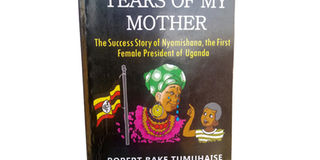Looking at the women’s cause

What you need to know:
If there is anything Robert Bake Tumuhaise’s latest release does more, it is pushing for the cause of women.
Tears of My Mother is a story of a woman who has long travailed but eventually prevailed. It is the story of a woman in a male-dominated world who despite being scorned and ridiculed for her barrenness clings to faith in God until her 40 years of patience pay off with her delivering a child who, as the subtitle reveals makes history by becoming the first female president of Uganda.
Here I could not help but indulge my curiosity as to what President Museveni might think of a title like this. In painting a character like Nyantahurira who personifies today’s political mafia that run the system, the author is speaking for Ugandans displeased with corruption and all the ills that have contaminated and stagnated the country, for which we would be justified to demand that it is high time the mantle passed on to a female leader.
After all Ellen Johnson Sirleaf and Joyce Banda are doing well in Liberia and Malawi respectively. And with tested women like Winnie Byanyima, Julia Ssebutinde,Rebecca Kadaga and Beti Kamya we would be spoilt for choice!
Feminists would love this novel not because it bashes men (it has its share of female characacters with unenviable foibles) but because of the way it depicts the steadfastness and pragmatism of women. Through its two central figures Hannah and her daughter Nyamishana, the endurance, resilience and fortitude of a woman is persuasively brought out.
They are portrayed as assertive in an inspirational way, challenging today’s patriarchs to give the girl-child a chance and tap the woman’s potential in the development process.
Hannah becomes a pacesetter when she defies the position her prejudiced society has assigned women, choosing to see unlimited possibilities for her daughter, delivered shortly after the death of her husband. When the elders pick a name with negative connotations, Hannah rejects it and names her daughter Nyamishana, which means sunshine.
This sunshine in Nyamishana’s personality is what dispels the darkness that threatens to destroy her. She comes out of prison and makes history by occupying the top office in the land. Nyamishana’s self-belief is nurtured by her mother who gets her to confess every day that she’s destined for greatness.
This is confirmed by a prophetess who appears on the day the child is named and proclaims that Nyamishana would “grow into a warrior dreaded by everyone” and liberate the nation. You wonder if this bit was inspired by the Biblical story of angel Gabriel telling Mary she would birth a child (Jesus Christ) who would redeem the world.
Then again, the prophetess could be a symbol of magic realism in which case the gods are responsible for Nyamishana’s success just like Ihuoma in Elechi Amadi’s The Concubine has no control over her conjugal life seeing that every man that comes into her life is destroyed by the powerful sea god.
Tears of my Mother, can as well be classified as a historical novel since it begins by taking us back to the last quarter of the 19th century when a real-life famine, Rwaramba, devastated south-western Uganda, turning some of the natives there into cannibals.
This famine coincided with the arrival of the Europeans on their civilisation/colonisation mission in Africa. Anyway, the reader gets an inside-out glimpse of what traditional life was like then with its legends, myths and endless rituals.
Published by World of Inspiration, the 138-page novel is simple but captivating. If you are not into sophisticated humour, you will find “Kay the rib-cracker” hilarious.
But the touch of experimentalism is what makes the novel uniquely fresh. The author blends fiction-writing techniques with those of non-fiction; switching from unpredictable manoeuvres that characterise most novels, to the motivational style he is known for in his non-fiction works such as Tapping God’s Blessings.
It reminds me of Irish writer James Joyce who distinguished himself with the characters’ inner thoughts and memories are transcribed as they arise. Maybe we can as well coin a name for Bake’s new style.




